The Economics and Statistics Division maintains archives of previous publications for accountability purposes, but makes no updates to keep these documents current with the latest data revisions from Statistics Canada. As a result, information in older documents may not be accurate. Please exercise caution when referring to older documents. For the latest information and historical data, please contact the individual listed to the right.
<--- Return to Archive
For additional information relating to this article, please contact:
May 29, 2020CANADIAN ECONOMIC ACCOUNTS Q1 2020
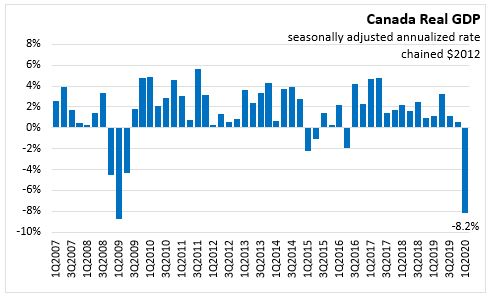
Real gross domestic product (GDP) growth declined 8.2 per cent (all figures seasonally adjusted at annual rates) in Canada in the first quarter of 2020 due to reduced household spending and widespread shutdowns of non-essential businesses in March, in response to the COVID-19 pandemic. Final domestic demand declined 6.0 per cent in the first quarter with declining household consumption and business investment. International trade declined in the first quarter. Statistics Canada notes that the sharpest decline in GDP since the first quarter of 2009 reflects measures imposed in March to contain the pandemic, such as school and non-essential business closures, border shutdowns, and travel restrictions, as well as events earlier in the quarter, mainly the Ontario teachers' strike and rail blockades in February.
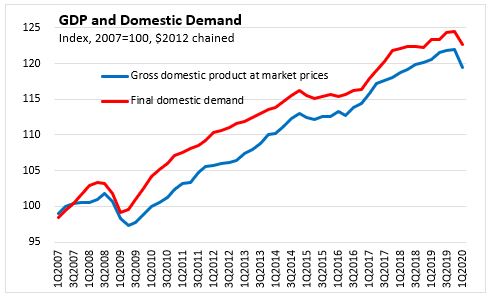
Household spending declined, the steepest quarterly decline ever recorded with declining goods (-6.5 per cent) and services (-10.8 per cent) consumption. Spending reductions were influenced by substantial job losses, income uncertainty, and limited opportunities to spend because of the mandatory closure of non-essential retail stores, restaurants and services, and restrictions on travel and tourism activities. Government final consumption expenditures decreased -3.8 per cent, the largest decline since the first quarter of 2013, reflecting school closures and curtailed government administration.
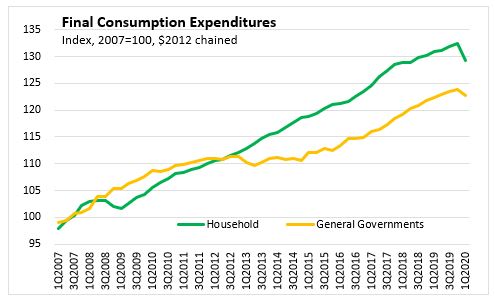
Housing investment declined to 0.4 per cent in Q1 after rising 1.2 per cent in the previous quarter. Both renovation activities and ownership transfer costs dropped, reflecting the need for physical distancing advocated by public health officials and enforced by governments. These declines were partly offset by an increase in new construction; construction of single-unit dwellings rebounded slightly, and construction of multiple-unit dwellings continued to grow for the fifth consecutive quarter.
Business investment in machinery and equipment (-13.1 per cent) was down for the fourth consecutive quarter, notably in communications and audio and video equipment and in industrial machinery and equipment, largely due to reduced imports. These declines were partly offset by an increase in aircraft and other transportation equipment. Engineering construction, intellectual property products and non-residential building construction were up.

Export and import volumes declined with exports (-11.3 per cent) falling for third consecutive quarter and imports (-10.7%) declining for a second consecutive quarter. Lower export volumes were reported in intermediate metal products, passenger cars and light trucks, refined petroleum and energy products and travel services. Drop in demand and depreciation of the Canadian dollar contributed to the drop in import volumes. Imports declined in travel services, tires, motor vehicle engines and parts, industrial machinery and equipment, and communication, and audio and video equipment.
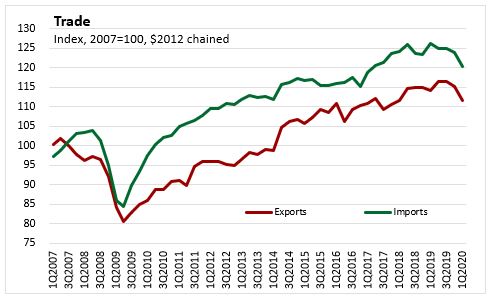
Inventories accumulation was down from $9.4 billion in Q4 2019 to -$2.0 billion in Q1 2020 due to supply chain disruptions, store closures, lower household demand and the higher economy-wide stock-to-sales ratio.

The terms-of-trade (ratio of price of exports to price of imports) was down with export prices declining for crude oil and crude bitumen and import prices rising, partly because of depreciation of the Canadian dollar. The overall GDP deflator was up 2.2 per cent on annualized basis.
Nominal GDP decreased 6.5 per cent in Q1, 2020. Annualized compensation of employees declined 3.4 per cent. The household savings rate has risen from 3.6 per cent in Q4 2019 to 6.1 per cent in Q1 2020. Net operating surplus of corporation declined 23.7 per cent after increasing 2.1 per cent in Q4 2019.
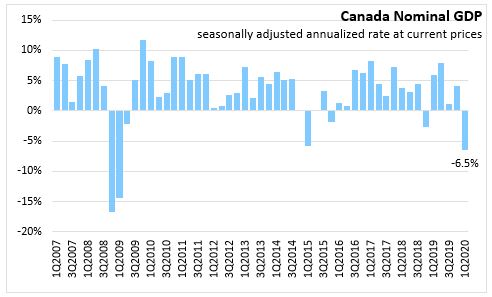
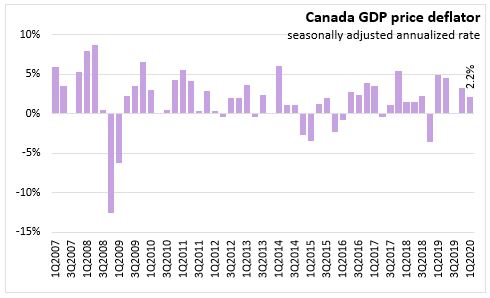
Source: Statistics Canada Tables 36-10-0103-01 and 36-10-0104-01
<--- Return to Archive